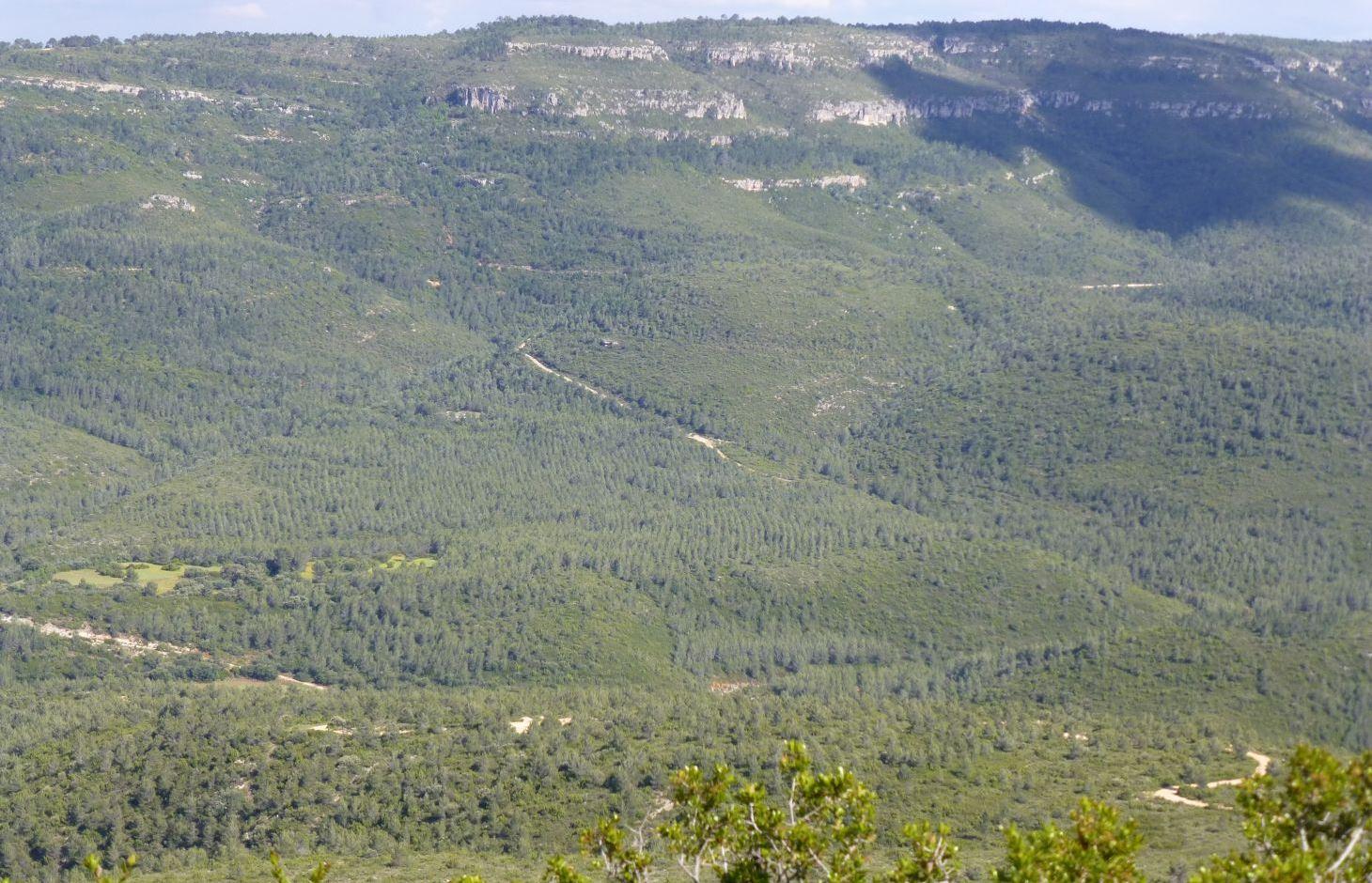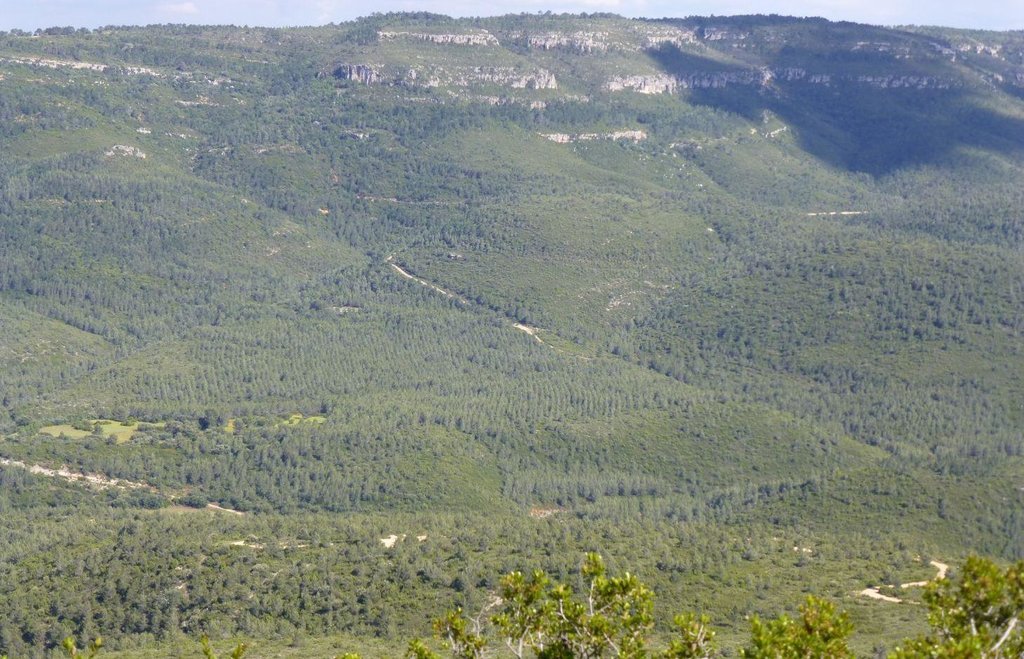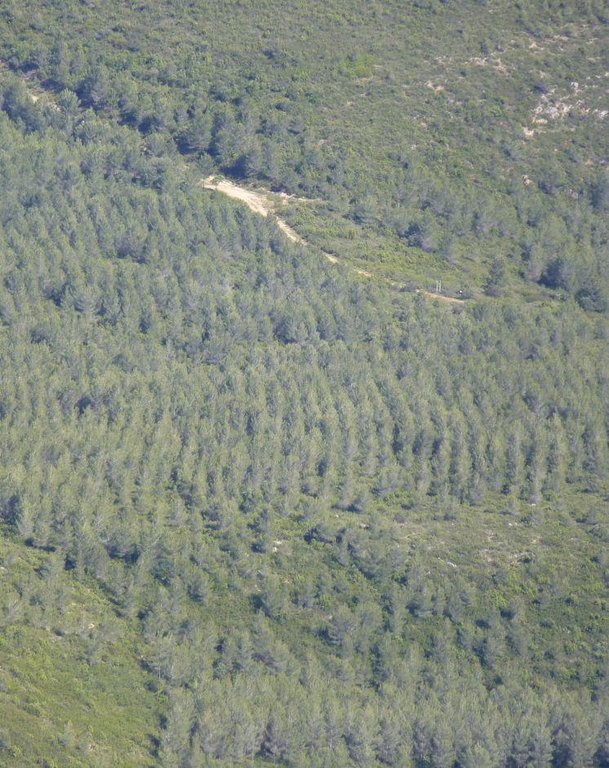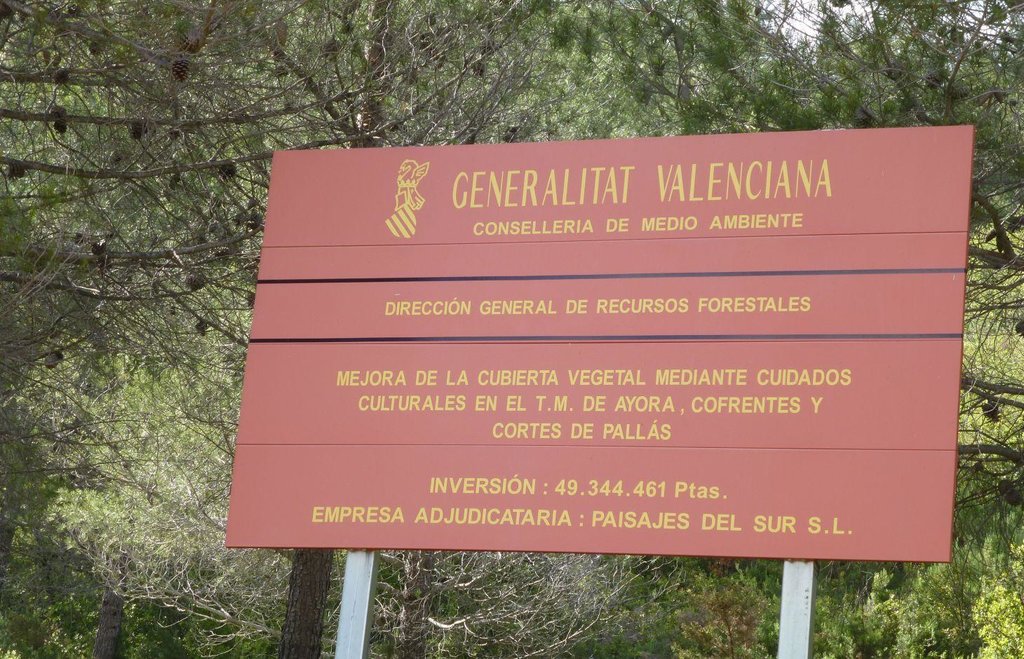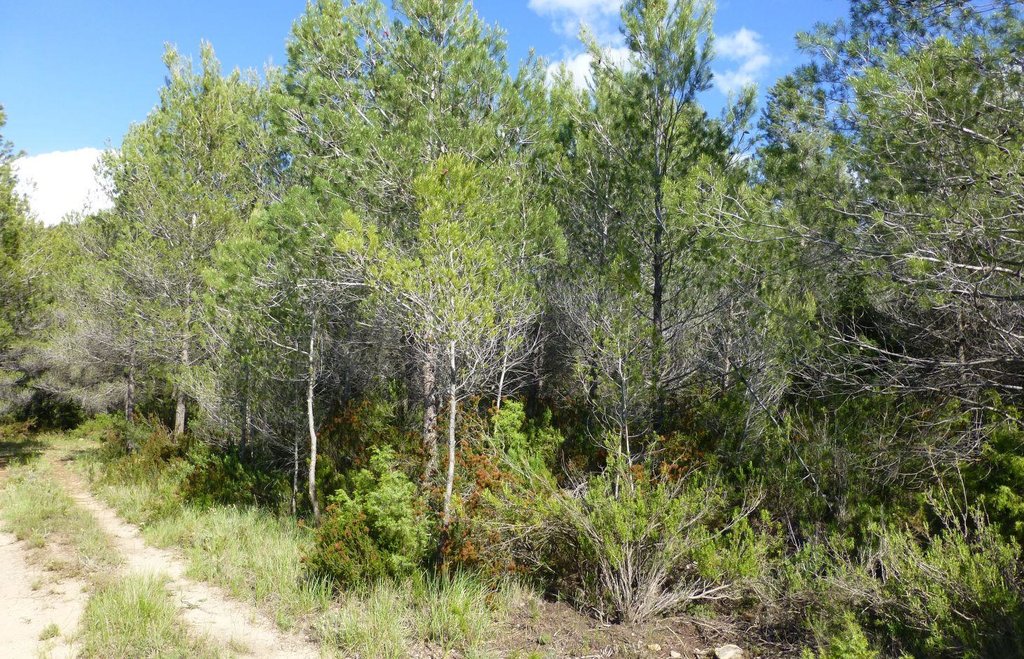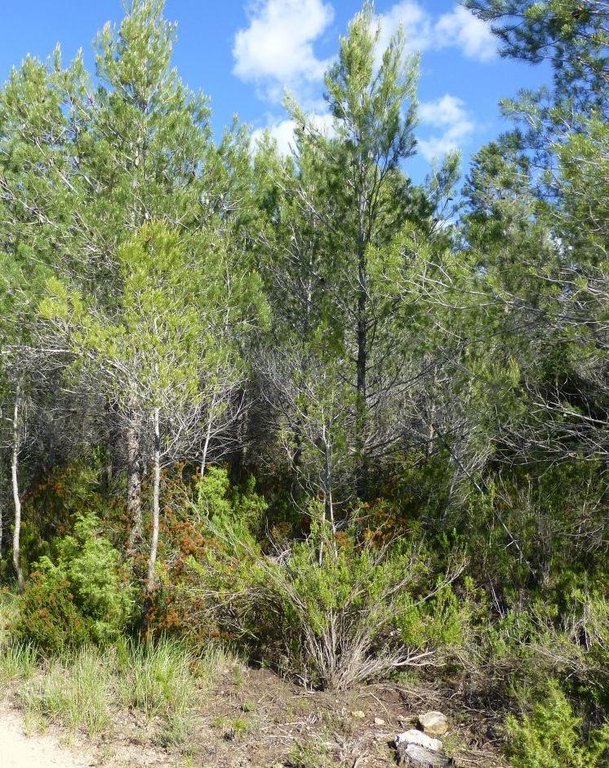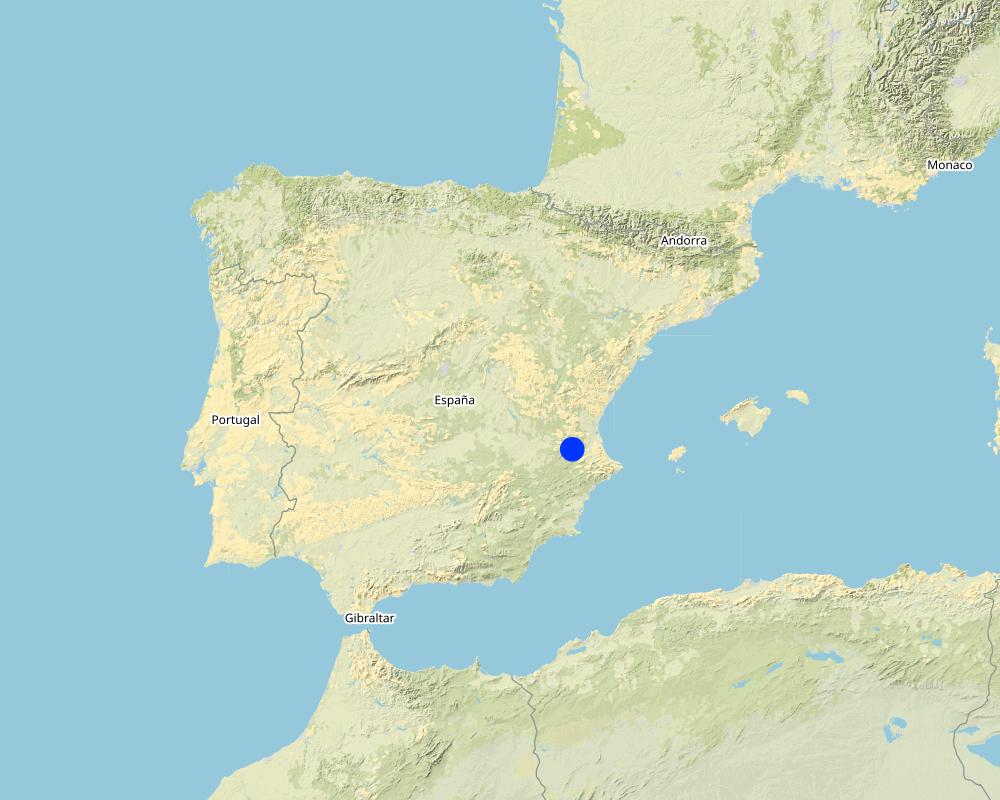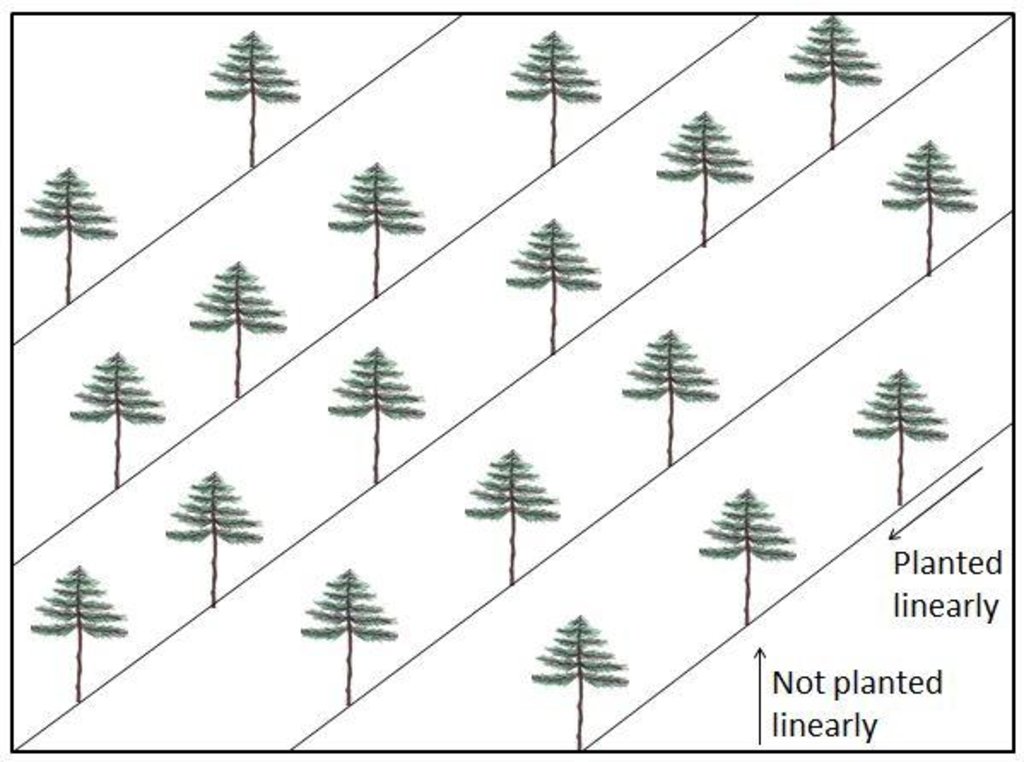Afforestation with Pinus Halepensis after the fire of 1979 (La Molinera) [ສະເປນ]
- ການສ້າງ:
- ປັບປູງ:
- ຜູ້ສັງລວມຂໍ້ມູນ: Nina Lauterburg
- ບັນນາທິການ: –
- ຜູ້ທົບທວນຄືນ: Alexandra Gavilano, Deborah Niggli, Hanspeter Liniger
Repoblación “La Molinera” con Pino Halepensis después del incendio del año 1979 (Spanish)
technologies_1584 - ສະເປນ
ເບິ່ງພາກສ່ວນ
ຂະຫຍາຍທັງໝົດ ຍຸບທັງໝົດ1. ຂໍ້ມູນທົ່ວໄປ
1.2 ຂໍ້ມູນ ການຕິດຕໍ່ພົວພັນ ຂອງບຸກຄົນທີ່ສໍາຄັນ ແລະ ສະຖາບັນ ທີ່ມີສ່ວນຮ່ວມ ໃນການປະເມີນເອກກະສານ ເຕັກໂນໂລຢີ
ຜຸ້ຊ່ຽວຊານ ດ້ານການຄຸ້ມຄອງ ທີ່ດິນແບບຍືນຍົງ:
Valdecantos Alejandro
Fundación Centro de Estudios Ambientales del Mediterráneo (CEAM)
ສະເປນ
ຜຸ້ຊ່ຽວຊານ ດ້ານການຄຸ້ມຄອງ ທີ່ດິນແບບຍືນຍົງ:
Colomer Vicente
Forest Agent Generalitat Valenciana (Conselleria de infraestructura, territorio y medio ambiente)
ສະເປນ
ຊື່ໂຄງການ ທີ່ອໍານວຍຄວາມສະດວກ ໃນການສ້າງເອກກະສານ/ປະເມີນ ເຕັກໂນໂລຢີ (ຖ້າກ່ຽວຂ້ອງ)
Catastrophic shifts in drylands (EU-CASCADE)ຊື່ສະຖາບັນ (ຫຼາຍສະຖາບັນ) ທີ່ອໍານວຍຄວາມສະດວກ ໃນການສ້າງເອກກະສານ / ປະເມີນ ເຕັກໂນໂລຢີ (ຖ້າກ່ຽວຂ້ອງ)
Centro de Estudios Ambientales del Mediterraneo (CEAM) - ສະເປນ1.3 ເງື່ອນໄຂ ກ່ຽວກັບ ການນໍາໃຊ້ຂໍ້ມູນເອກະສານ ທີ່ສ້າງຂື້ນ ໂດຍຜ່ານ ອົງການພາບລວມຂອງໂລກ ທາງດ້ານແນວທາງ ແລະ ເຕັກໂນໂລຢີ ຂອງການອານຸລັກ ທໍາມະຊາດ (WOCAT)
ຜູ້ປ້ອນຂໍ້ມູນ ແລະ ບຸກຄົນສຳຄັນ ທີ່ໃຫ້ຂໍ້ມູນ (ຫຼາຍ) ຍິນຍອມ ຕາມເງື່ອນໄຂ ໃນການນຳໃຊ້ຂໍ້ມູນ ເພື່ອສ້າງເປັນເອກກະສານຂອງ WOCAT:
ແມ່ນ
1.4 ແຈ້ງການວ່າ ດ້ວຍຄວາມຍືນຍົງຂອງ ເຕັກໂນໂລຢີ
ການນໍາໃຊ້ ເຕັກໂນໂລຢີ ດັ່ງກ່າວໄດ້ອະທິບາຍ ເຖິງບັນຫາ ກ່ຽວກັບ ການເຊື່ອມໂຊມຂອງດິນບໍ? ຖ້າບໍ່ດັ່ງນັ້ນ ມັນບໍ່ສາມາດ ຢັ້ງຢືນໄດ້ວ່າ ເປັນເຕັກໂນໂລຊີ ໃນການຄຸ້ມຄອງ ທີ່ດິນແບບຍືນຍົງ? :
ບໍ່ແມ່ນ
2. ການອະທິບາຍ ເຕັກໂນໂລຢີ ຂອງການຄຸ້ມຄອງ ທີ່ດິນແບບຍືນຍົງ
2.1 ຄໍາອະທິບາຍສັ້ນຂອງ ເຕັກໂນໂລຢີ
ການກຳໜົດຄວາມໝາຍ ຂອງເຕັກໂນໂລຢີ:
Post-fire afforestation with Pinus Halepensis to reduce soil erosion and to enhance forest growth.
2.2 ການອະທິບາຍ ລາຍລະອຽດ ຂອງເຕັກໂນໂລຢີ
ການພັນລະນາ:
As a consequence of the devastating fire of the year 1979 which destroyed 33’000 ha of forest, strong erosion processes occurred on the bare soil and hindered the vegetation to regrow. Furthermore, this region was already abandoned (rural exodus) and missing management practices increased the problem of erosion. Therefore the government mandated to afforest the burnt areas in 1985.
The main purpose of the afforestation was to reduce the soil erosion (which was severe at that time) by planting trees, which increases soil stability and enables forest growth again. But the state also wanted to ensure wood extraction in the future. Furthermore, the visual impact was an important driver for afforesting this area.
The afforestation was executed in the winter of 1985 (November-February/March) by the regional forest services (Conselleria de agricultura). Forest engineers, who worked for the state and planned the project, collaborated with forest agents whereas the involved forest agents contracted local villagers to help afforesting these areas. The forest agent acted as a link between engineer and forest brigade and controlled if the brigade executed what the engineer proposed. He also provided assistance to the workers. The forest brigade was paid by day-if it was raining, people did not work and did not get any salary.
Nobody could provide direct information on the afforestation process in 1985 but there are not many differences of how they did it in the past and how it works today. The planting holes (60cm x 60cm x 60cm) were created with a machine (Caterpillar) using a “spoon” to open a hole and cover it again. This process loosens the soil (only possible in soils which are free from big stones). It should be noted that they did not use a ripper, they knew that the soil is destroyed using this technique. The seedlings were planted manually by the forest workers and arranged linearly because this facilitated the handling of the machines. Since the soil had a low stone content, it was suitable for the establishment of a forest.
The afforested area covered around 100 ha (not continuously). Today, the costs of an afforestation are around 1500 Euro per ha, but in the past it was less expensive. They only planted Pinus Halepensis. Today, a seedling of this tree species costs between 20 and 60 Cents. If the regional forest services have their own nurseries, they do not need to spend money to buy seedlings.
The success of an afforestation depends on numerous factors such as aspect and humidity (better on north-facing slopes), soil amount/fertility (better conditions on former cultivated fields), origin of the seedlings (adapted to the local climatic conditions), variability/uncertainty of the weather conditions (e.g. droughts, freezing). Usually a plantation is done in October/November and therefore especially the first summer determines the success. If it is too dry the plant will not grow (roots are too short to reach the humidity deeper in the ground). Further, the availability of trained people and the selection of appropriate machines are crucial.
The documented afforestation is one of a few examples of afforestation trials which succeeded. Today there is a forest where young pines are growing naturally ("children" of the planted ones), but also resprouter species (e.g. Quercus) can be found, which regenerated without having been planted and apparently were dispersed by birds.
But there are also some problems related to this afforestation. The forest agent explained that there is a high pest risk since monoplantations are less resilient to diseases (sick or dead plants in turn increase the fire risk). Another problem is that the trees were planted too densely (800-1000 plants per ha with a spacing of 5-10m) which requires recurrent management of the forest. Knowing about this problem, around the year 2003 they managed the area doing a selective clearing to reduce both the continuity and the competition between the species and thus also reduced the fire risk (“ayuda regeneración”). But the forest has become extremely dense again, thus increasing the risk of fires. There is a need to manage this area again and to extract biomass (selective clearing), but unfortunately no management project is planned for the near future.
The region of Ayora is mountainous with a dry subhumid climate (~380 mm annual rainfall). The risk of fire incidence is at its highest from June to September when there are adverse conditions like drought, high temperatures and strong winds (mainly the winds coming from central Spain, called “poniente”).
The population density is very low and there are only few job opportunities (e.g. marginal agriculture, grazing, hunting, beekeeping). The plantation provided jobs for rural people. Also today forest management could be a source for jobs.
2.3 ຮູບພາບຂອງເຕັກໂນໂລຢີ
2.5 ປະເທດ / ເຂດ / ສະຖານທີ່ບ່ອນທີ່ ເຕັກໂນໂລຢີ ໄດ້ຮັບການນໍາໃຊ້ ແລະ ທີ່ຖືກປົກຄຸມດ້ວຍການປະເມີນຜົນ
ປະເທດ:
ສະເປນ
ພາກພື້ນ / ລັດ / ແຂວງ:
Spain, Valencia
ຂໍ້ມູນເພີ່ມເຕີມຂອງສະຖານທີ່:
Ayora, La Molinera
ໃຫ້ລະບຸ ການແຜ່ຂະຫຍາຍ ເຕັກໂນໂລຢີ:
- ແຜ່ຂະຫຍາຍຢ່າງໄວວາໃນພື້ນທີ່
ຖ້າຫາກບໍ່ຮູ້ເນື້ອທີ່ທີ່ແນ່ນອນ, ໃຫ້ລະບຸ ເນື້ອທີ່ໂດຍປະມານ ທີ່ໃກ້ຄຽງ:
- 0.1-1 ກມ 2
ຄວາມຄິດເຫັນ:
Boundary points of the Technology area: In the kmz file the whole afforestation of 1985/1986 is shown but it is not clear whether the whole area was afforested successfully. The coordinates indicated above show the location I visited which had success.
Map
×2.6 ວັນທີໃນການຈັດຕັ້ງປະຕິບັດ
ຖ້າຫາກວ່າ ບໍ່ຮູ້ຈັກ ປີທີ່ຊັດເຈນ ແມ່ນໃຫ້ປະມານ ວັນທີເອົາ:
- 10-50 ປີ ຜ່ານມາ
2.7 ການນໍາສະເໜີ ເຕັກໂນໂລຢີ
ໃຫ້ລະບຸ ເຕັກໂນໂລຢີ ໄດ້ຖືກຈັດຕັ້ງປະຕິບັດຄືແນວໃດ?
- ໂດຍຜ່ານໂຄງການ / ການຊ່ວຍເຫຼືອຈາກພາຍນອກ
ຄວາມຄິດເຫັນ (ປະເພດ ໂຄງການ ແລະ ອື່ນໆ):
The project was designed by the regional forest services of Valencia in 1985 (“Conselleria de agricultura” at that time, today it is called “Conselleria de infraestructura, territorio y medio ambiente”).
3. ການໃຈ້ແຍກ ເຕັກໂນໂລຢີ ໃນການຄຸ້ມຄອງ ດິນແບບຍືນຍົງ
3.1 ຈຸດປະສົງຫຼັກ (ຫຼາຍ) ຂອງເຕັກໂນໂລຢີ
- ຫຼຸດຜ່ອນ, ປ້ອງກັນ, ຟື້ນຟູ ການເຊື່ອມໂຊມຂອງດິນ
- ການອະນຸລັກ ລະບົບນິເວດ
3.2 ປະເພດການນໍາໃຊ້ທີ່ດິນ ໃນປະຈຸບັນ() ທີ່ເຕັກໂນໂລຢີ ໄດ້ຖືກນໍາໃຊ້

ປ່າໄມ້ / ປ່າ
ປະເພດຂອງຕົ້ນໄມ້:
- ສາຍພັນໝາກກໍ່
ຜົນຜະລິດ ແລະ ການບໍລິການ:
- ເຄື່ອງປ່າຂອງດົງ
- ໝາກໄມ້ ແລະ ແກ່ນຖົ່ວ
- ຜະລິດຕະພັນ ປ່າໄມ້ອື່ນໆ
- ການອະນຸລັກທໍາມະຊາດ / ການປ້ອງກັນ
- ປ້ອງກັນ ການຄຸກຄາມ ທາງທໍາມະຊາດ
- hunting
ຄວາມຄິດເຫັນ:
Major land use problems (compiler’s opinion): The past land use resulted in a change of the vegetation composition (e.g. through removal of resprouter species). Due to rural exodus and land abandonment, the natural succession took place and fire-prone early-successional species colonized the abandoned fields. The vegetation grew without any control which seems to have caused the devastating fire of the year 1979 which destroyed 33’000 ha of forest. As a consequence of this fire, strong erosion processes occurred on the bare soil and hindered the vegetation to regrow. Furthermore, people which still lived there lost their properties after the fire and moved away as well. A consequence of the depopulation was a lack of management practices which increased the problem of post-fire erosion.
Number of growing seasons per year:
1
3.5 ການນໍາໃຊ້ເຕັກໂນໂລຢີ ທີ່ຢູ່ໃນກຸ່ມການຄຸ້ມຄອງ ທີ່ດິນແບບຍືນຍົງ
- ການຄຸ້ມຄອງການປູກປ່າ
3.6 ມາດຕະການ ການຄຸ້ມຄອງ ທີ່ດິນແບບຍືນຍົງ ປະກອບດ້ວຍ ເຕັກໂນໂລຢີ

ມາດຕະການ ທາງດ້ານພືດພັນ
- V1: ເປັນໄມ້ຢືນຕົ້ນ ແລະ ການປົກຫຸ້ມຂອງໄມ້ພຸ່ມ
ຄວາມຄິດເຫັນ:
Type of vegetative measures: aligned: -linear
3.7 ປະເພດດິນເຊື່ອມໂຊມ ຫຼັກທີ່ໄດ້ນໍາໃຊ້ ເຕັກໂນໂລຢີ

ດິນເຊາະເຈື່ອນ ໂດຍນໍ້າ
- Wt: ການສູນເສຍຊັ້ນໜ້າດິນ / ການເຊາະເຈື່ອນຜິວໜ້າດິນ

ການເຊື່ອມໂຊມ ທາງຊີວະພາບ
- Bc: ການຫຼຸດຜ່ອນການປົກຫຸ້ມຂອງພືດ
- Bf: ຜົນກະທົບ ຄວາມເສຍຫາຍ ຈາກໄຟໄໝ້
ຄວາມຄິດເຫັນ:
Main causes of degradation: deforestation / removal of natural vegetation (incl. forest fires) (Deforestation in the past (removal of resprouter species), land abandonment, uncontrolled growth of fire-prone vegetation, afforestations. The fire of 1979 destroyed 33'000 ha of forest.), population pressure (Vast areas were deforested in the past for agriculture, important key species were removed. After land abandonment there was a lack of management strategies), land tenure (After the fire, many people lost their properties and had to move away, therefore no management for post-fire erosion was applied.), labour availability (In the past there was outmigration from the region to the big cities and therefore there was a lack of management before and after the fire.), inputs and infrastructure: (roads, markets, distribution of water points, other, …) (The huge fire of 1979 could not be stopped easily because of the lack of fire extinction media like water ponds, streets, transport media (this has been improved now))
3.8 ການປ້ອງກັນ, ການຫຼຸດຜ່ອນ, ຫຼືການຟື້ນຟູຂອງການເຊື່ອມໂຊມຂອງດິນ
ໃຫ້ລະບຸ ເປົ້າໝາຍ ເຕັກໂນໂລຢີ ທີ່ພົວພັນ ກັບຄວາມເຊື່ອມໂຊມຂອງດິນ:
- ປ້ອງກັນການເຊື່ອມໂຊມຂອງດິນ
- ການຟື້ນຟູ / ຟື້ນຟູດິນທີ່ຊຸດໂຊມ
4. ຂໍ້ກໍາໜົດ, ກິດຈະກໍາການປະຕິບັດ, ວັດຖຸດິບ, ແລະຄ່າໃຊ້ຈ່າຍ
4.1 ເຕັກນິກ ໃນການແຕ້ມແຜນວາດ ເຕັກໂນໂລຢີ
ຄຸນລັກສະນະ ຂອງເຕັກນິກ (ທີ່ກ່ຽວຂ້ອງ ກັບການແຕ້ມແຜນວາດ ທາງດ້ານເຕັກນີກ):
The Pinus Halepensis seedlings were planted on a line in order to facilitate the operation of machines. The linear arrangement is still visible when observing the plantation from the distance, but when finding oneself within the forest this alignment is not visible anymore since the forest grew very densely. A part of today's forest grew naturally after planting the trees - some young pines but also some resprouters (e.g. Quercus) can be found which is pleasant and shows the success of this plantation effort. However, it would have been better to plant less trees with a bigger distance between the individuals.
To reduce the high density and continuity of the forest (and thus to reduce the fire risk) a selective clearing would be required but currently the state does not invest money in forest management practices. Without extraction of biomass this dense forest contains a high risk of fire.
Location: Ayora. Valencia, Spain
Date: 11-12-2013
Technical knowledge required for field staff / advisors: high (The forest agent needs a high technical knowledge. He acts as a link between engineer and forest brigade and controls if the brigade executes what the engineer dictates. He also provides assistance.)
Technical knowledge required for Engineer: high (The forest engineer works for the state and plans the project, therefore he needs a high technical knowledge)
Technical knowledge required for Forest brigade/workers: low (The forest workers only execute what the engineer and the forest agent tell them. They need to know how to handle the machines but don’t have to judge where to plant which species.)
Main technical functions: control of raindrop splash, control of dispersed runoff: retain / trap, control of dispersed runoff: impede / retard, control of concentrated runoff: retain / trap, control of concentrated runoff: impede / retard, improvement of ground cover, stabilisation of soil (eg by tree roots against land slides), sediment retention / trapping, sediment harvesting, increase of biomass (quantity)
Secondary technical functions: increase of surface roughness, increase in organic matter, increase in nutrient availability (supply, recycling,…), increase of infiltration, promotion of vegetation species and varieties (quality, eg palatable fodder)
Aligned: -linear
Vegetative material: T : trees / shrubs
Number of plants per (ha): 800-1000
Vertical interval within rows / strips / blocks (m): 5-10
Trees/ shrubs species: Pinus Halepensis
ຜູ້ຂຽນ:
Nina Lauterburg
4.2 ຂໍ້ມູນທົ່ວໄປກ່ຽວກັບການຄິດໄລ່ປັດໃຈຂາເຂົ້າໃນການຜະລິດ ແລະ ມູນຄ່າອື່ນໆ
ສະກຸນເງິນອື່ນໆ / ປະເທດອື່ນໆ (ລະບຸ):
Euro
ຖ້າກ່ຽວຂ້ອງ, ໃຫ້ລະບຸອັດຕາແລກປ່ຽນຈາກ USD ເປັນສະກຸນເງິນທ້ອງຖິ່ນ (ເຊັ່ນ: 1 USD = 79.9 Brazilian Real): 1 USD =:
0.74
ລະບຸ ຄ່າຈ້າງ ຄ່າແຮງງານສະເລ່ຍ ຕໍ່ ວັນ:
47.00
4.3 ການສ້າງຕັ້ງກິດຈະກໍາ
| ກິດຈະກໍາ | Timing (season) | |
|---|---|---|
| 1. | Digging holes (60cm x 60cm x 60cm) | Once (1985), between November and February/March |
| 2. | Plantation of the seedlings (pinus halepensis) | Once (1985), between November and February/March |
4.4 ຕົ້ນທຶນ ແລະ ປັດໄຈຂາເຂົ້າທີ່ຈໍາເປັນໃນຈັດຕັ້ງປະຕິບັດ
| ລະບຸ ປັດໃຈ ນໍາເຂົ້າ ໃນການຜະລີດ | ຫົວໜ່ວຍ | ປະລິມານ | ຕົ້ນທຶນ ຕໍ່ຫົວໜ່ວຍ | ຕົ້ນທຶນທັງໝົດ ຂອງປັດໃຈຂາເຂົ້າ ໃນການຜະລິດ | % ຂອງຕົ້ນທຶນທັງໝົດ ທີ່ຜູ້ນໍາໃຊ້ທີ່ດິນ ໃຊ້ຈ່າຍເອງ | |
|---|---|---|---|---|---|---|
| ອຸປະກອນ | machine use | ha | 1.0 | 4857.0 | 4857.0 | |
| ຕົ້ນທຶນທັງໝົດ ໃນການຈັດຕັ້ງປະຕິບັດ ເຕັກໂນໂລຢີ | 4857.0 | |||||
| ຄ່າໃຊ້ຈ່າຍທັງໝົດ ສຳລັບການສ້າງຕັ້ງເຕັກໂນໂລຢີ ເປັນສະກຸນເງີນໂດລາ | 6563.51 | |||||
ຄວາມຄິດເຫັນ:
Duration of establishment phase: 4 month(s)
4.5 ບໍາລຸງຮັກສາ / ແຜນຈັດຕັ້ງປະຕິບັດ ກິດຈະກໍາ
| ກິດຈະກໍາ | ໄລຍະເວລາ / ຄວາມຖີ່ | |
|---|---|---|
| 1. | Selective clearing "ayuda regeneración" (only done once in 2003 but should be done again to decrease the risk of fires and competition between species) | late spring 2003 |
4.6 ຄ່າໃຊ້ຈ່າຍ ແລະ ປັດໄຈນໍາເຂົ້າທີ່ຈໍາເປັນສໍາລັບການບໍາລຸງຮັກສາກິດຈະກໍາ / ແຜນປະຕິບັດ (ຕໍ່ປີ)
| ລະບຸ ປັດໃຈ ນໍາເຂົ້າ ໃນການຜະລີດ | ຫົວໜ່ວຍ | ປະລິມານ | ຕົ້ນທຶນ ຕໍ່ຫົວໜ່ວຍ | ຕົ້ນທຶນທັງໝົດ ຂອງປັດໃຈຂາເຂົ້າ ໃນການຜະລິດ | % ຂອງຕົ້ນທຶນທັງໝົດ ທີ່ຜູ້ນໍາໃຊ້ທີ່ດິນ ໃຊ້ຈ່າຍເອງ | |
|---|---|---|---|---|---|---|
| ອຸປະກອນ | machine use | ha | 1.0 | 2428.0 | 2428.0 | |
| ຕົ້ນທຶນທັງໝົດ ທີ່ໃຊ້ໃນການບໍາລຸງຮັກສາ ເຕັກໂນໂລຢີ | 2428.0 | |||||
| ຄ່າໃຊ້ຈ່າຍທັງໝົດ ສຳລັບການບົວລະບັດຮກສາເຕັກໂນໂລຢີ ເປັນສະກຸນເງີນໂດລາ | 3281.08 | |||||
ຄວາມຄິດເຫັນ:
The costs were calculated for the application of the technology on one hectare. Furthermore, the total costs of the afforestation were calculated with today’s costs because the costs at the time it was implemented are not known.
The currency rate (Euro-Dollar) was calculated on November 16th, 2013.
4.7 ປັດໄຈ ທີ່ສໍາຄັນ ທີ່ສົ່ງຜົນກະທົບ ຕໍ່ຄ່າໃຊ້ຈ່າຍ
ໃຫ້ອະທິບາຍ ປັດໃຈ ທີ່ສົ່ງຜົນກະທົບ ຕໍ່ຕົ້ນທຶນ ໃນການຈັດຕັ້ງປະຕິບັດ:
The costs of a plantation can be affected by numerous factors, such as slope (if the slope is steep, the work is much more difficult and takes more time, also because machines cannot be used on steep slopes), distance from a street (people can work less in a day if they have to walk far to plant), stone content of the soil (if there are many stones the work is much more difficult for the machines), soil type (plantations work much better on previous cropland because the soil is more fertile), origin of the seedlings (adapted to the local climatic conditions), variability/uncertainty of the weather conditions (e.g. droughts, freezing). If there are adverse climatic conditions or other negative circumstances the afforestation will not work well and this might cause higher costs.
5. ສະພາບແວດລ້ອມທໍາມະຊາດ ແລະ ມະນຸດ
5.1 ອາກາດ
ປະລິມານນໍ້າຝົນປະຈໍາປີ
- < 250 ມີລິແມັດ
- 251-500 ມີລິແມັດ
- 501-750 ມີລິແມັດ
- 751-1,000 ມີລິແມັດ
- 1,001-1,500 ມີລິແມັດ
- 1,501-2,000 ມີລິແມັດ
- 2,001-3,000 ມີລິແມັດ
- 3,001-4,000 ມີລິແມັດ
- > 4,000 ມີລິແມັດ
ຂໍ້ມູນສະເພາະ / ຄວາມເຫັນກ່ຽວກັບ ປະລິມານນໍ້າຝົນ:
Ayora: 383mm
ເຂດສະພາບອາກາດກະສິກໍາ
- ເຄີ່ງຄວາມຊຸ່ມ
Thermal climate class: temperate
5.2 ພູມິປະເທດ
ຄ່າສະເລ່ຍ ຄວາມຄ້ອຍຊັນ:
- ພື້ນທີ່ຮາບພຽງ (0-2%)
- ອ່ອນ (3-5 %)
- ປານກາງ (6-10 %)
- ມ້ວນ (11-15 %)
- ເນີນ(16-30%)
- ໍຊັນ (31-60%)
- ຊັນຫຼາຍ (>60%)
ຮູບແບບຂອງດິນ:
- ພູພຽງ / ທົ່ງພຽງ
- ສັນພູ
- ເປີ້ນພູ
- ເນີນພູ
- ຕີນພູ
- ຮ່ອມພູ
ເຂດລະດັບສູງ:
- 0-100 ແມັດ a.s.l.
- 101-500 ແມັດ a.s.l.
- 501-1,000 ແມັດ a.s.l.
- 1,001-1,500 ແມັດ a.s.l.
- 1,501-2,000 ແມັດ a.s.l.
- 2,001-2,500 ແມັດ a.s.l.
- 2,501-3,000 ແມັດ a.s.l.
- 3,001-4,000 ແມັດ a.s.l.
- > 4,000 ແມັດ a.s.l.
5.3 ດິນ
ຄວາມເລິກ ຂອງດິນສະເລ່ຍ:
- ຕື້ນຫຼາຍ (0-20 ຊັງຕີແມັດ)
- ຕື້ນ (21-50 ຊຕມ)
- ເລີກປານກາງ (51-80 ຊຕມ)
- ເລິກ (81-120 ຊມ)
- ເລິກຫຼາຍ (> 120 cm)
ເນື້ອດິນ (ໜ້າດິນ):
- ບາງລະອຽດ / ໜັກ (ໜຽວ)
ຊັ້ນອິນຊີວັດຖຸ ເທິງໜ້າດິນ:
- ປານກາງ (1-3 %)
5.4 ມີນໍ້າ ແລະ ຄຸນນະພາບ
ລະດັບ ນໍ້າໃຕ້ດິນ:
5-50 ແມັດ
ການມີນໍ້າ ເທິງໜ້າດິນ:
ທຸກຍາກ / ບໍ່ມີ
ຄຸນນະພາບນໍ້າ (ບໍ່ມີການບໍາບັດ):
ມີນໍ້າດື່ມ
5.5 ຊີວະນາໆພັນ
ຄວາມຫຼາກຫຼາຍ ທາງສາຍພັນ:
- ປານກາງ
5.6 ຄຸນລັກສະນະ ຂອງຜູ້ນໍາໃຊ້ທີ່ດິນ ທີ່ໄດ້ນໍາໃຊ້ເຕັກໂນໂລຢີ
ລະບົບ ການຕະຫຼາດ ແລະ ຜົນຜະລິດ:
- ປະສົມປົນເປ( ກຸ້ມຕົນເອງ/ເປັນສິນຄ້າ)
ບຸກຄົນ ຫຼື ກຸ່ມ:
- ການຈ້າງງານ (ບໍລິສັດ, ອົງການ ລັດຖະບານ)
ເພດ:
- ຜູ້ຊາຍ
ໃຫ້ລະບຸ ຄຸນລັກສະນະ ຂອງຜູ້ນໍາໃຊ້ທີ່ດິນ:
Land users applying the Technology are mainly common / average land users
Difference in the involvement of women and men: The work was mainly done by men, because it is heavy work and it is not usual that women are working in the forest.
Population density: < 10 persons/km2
Annual population growth: negative
5.8 ເຈົ້າຂອງທີ່ດິນ, ສິດໃຊ້ທີ່ດິນ, ແລະ ສິດທິການນໍາໃຊ້ນໍ້າ
ເຈົ້າຂອງດິນ:
- ລັດ
- ບຸກຄົນ, ທີ່ມີຕໍາແໜ່ງ
ສິດທິ ໃນການນໍາໃຊ້ທີ່ດິນ:
- ບຸກຄົນ
- public/open access but organised (e.g. hunting)
- public/open access but organised (e.g. hunting)
ຄວາມຄິດເຫັນ:
In the region, there is some public land, controlled by the state. But there is also some private land. The access to the public land is open but organized. Permission is needed from the government to cut trees, to build a house or to hunt. There are some private hunting areas for which the hunting association has to pay a fee.
6. ຜົນກະທົບ ແລະ ລາຍງານສະຫຼຸບ
6.1 ການສະແດງຜົນກະທົບ ພາຍໃນພື້ນທີ່ ທີ່ໄດ້ຈັດຕັ້ງປະຕິບັດ ເຕັກໂນໂລຢີ
ຜົນກະທົບທາງເສດຖະກິດສັງຄົມ
ການຜະລິດ
ຜົນຜະລິດຂອງສັດ
ຄວາມຄິດເຫັນ / ລະບຸແຈ້ງ:
After planting, grazing should be banned/restricted
ຜົນຜະລິດໄມ້
ຄວາມຄິດເຫັນ / ລະບຸແຈ້ງ:
The natural process of vegetation growth was accelerated through the plantation of pines. There will be more wood in the future (develops only slowly).
ຄວາມໜາແໜ້ນ ຂອງຜົນຜະລິດ
ຄວາມຄິດເຫັນ / ລະບຸແຈ້ງ:
Wood, hunting, mushrooms
ເນື້ອທີ່ການຜະລິດ
ຄວາມຄິດເຫັນ / ລະບຸແຈ້ງ:
Less agricultural land available (but the question is also if the land would be used for agriculture since it is quite a remote area)
ການຜະລິດພະລັງງານ
ຜົນກະທົບດ້ານວັດທະນາທໍາສັງຄົມ
ໂອກາດ ໃນການພັກຜ່ອນຢ່ອນໃຈ
ຄວາມຄິດເຫັນ / ລະບຸແຈ້ງ:
Forest has a higher aesthetic value than a burnt area or shrubland. In general people are attracted by afforestations, but since this afforestation has been done in a remote area people don’t visit this place more frequently
ຄວາມຮູ້ກ່ຽວກັບ ການຄຸ້ມຄອງ ທີ່ດິນແບບຍືນຍົງ / ການເຊື່ອມໂຊມຂອງດິນ
ຄວາມຄິດເຫັນ / ລະບຸແຈ້ງ:
Local people know about the importance of conservation of the area and like to have a healthy forest which is protected from wildfires.
ການຫຼຸດຜ່ອນ ຂໍ້ຂັດແຍ່ງ
ສະຖານະການຂອງສັງຄົມ ແລະ ກຸ່ມດ້ອຍໂອກາດທາງເສດຖະກິດ
ຄວາມຄິດເຫັນ / ລະບຸແຈ້ງ:
The afforestation provided many job opportunities (in the year 1985, today not anymore)
contribution to human well-being
ຄວາມຄິດເຫັນ / ລະບຸແຈ້ງ:
In the year 1985 the afforestation created jobs for the unemployed. But it seems that in general forest management is not something people want to do, they work in this sector only if there are no other job opportunities. Until today this attitude did not change much. Forest management means a hard job and this kind of work is not well-respected in society.
ຜົນກະທົບຕໍ່ລະບົບນິເວດ
ວົງຈອນນໍ້າ / ນໍ້າ
ການຂຸດຄົ້ນ / ການເກັບກັກນໍ້າ
ການໄຫຼ ຂອງນໍ້າໜ້າດິນ
ການລະບາຍນໍ້າ
ຊັ້ນນໍ້າໄຕ້ດິນ / ນໍ້າ
ການລະເຫີຍອາຍ
ຄວາມຄິດເຫັນ / ລະບຸແຈ້ງ:
More moisture is stored in the soil and less water is lost by evaporation (the soil is covered)
ດິນ
ຄວາມຊຸ່ມຂອງດິນ
ຄວາມຄິດເຫັນ / ລະບຸແຈ້ງ:
More soil moisture because of vegetation cover (soil is not exposed and does therefore not dry out)
ການປົກຄຸມຂອງດິນ
ການສູນເສຍດິນ
ດິນເປັນຜົງ / ການຈັບໂຕຂອງດິນ ທີ່ມີຂະໜາດນ້ອຍຫຼາຍ ທີ່ມີການຈັບໂຕກັນເປັນກ້ອນ
ວົງຈອນ ຂອງສານອາຫານໃນດິນ
ອິນຊີວັດຖຸໃນດິນ / ຢູ່ລຸ່ມຊັ້ນດິນ C
ຊີວະນານາພັນ: ສັດ, ພືດ
ມວນຊີວະພາບ / ຢູ່ເທິງຊັ້ນດິນ C
ຄວາມຫຼາກຫຼາຍຂອງພືດ
ຄວາມຄິດເຫັນ / ລະບຸແຈ້ງ:
Today different plant species can be found although only pines (Pinus Halepensis) was planted
ຄວາມຫຼາກຫຼາຍຂອງສັດ
ຄວາມຄິດເຫັນ / ລະບຸແຈ້ງ:
There are maybe more animals because of shelter, different vegetation composition, and fodder supply. Hunters also cultivate some fields in this region to attract the game.
ການຄວບຄຸມສັດຕູພືດ / ພະຍາດ
ການຫຼຸດຜ່ອນ ຄວາມສ່ຽງ ຈາກໄພພິບັດ ແລະ ອາກາດປ່ຽນແປງ
ຄວາມສ່ຽງ ຈາກໄຟໄໝ້
ຄວາມຄິດເຫັນ / ລະບຸແຈ້ງ:
Higher fire risk than if there would be agriculture or bare land. Lack of forest management resulted in a high density of the vegetation which increases the risk of fire
ຄວາມຮູນແຮງ ຂອງລົມ
ຄວາມຄິດເຫັນ / ລະບຸແຈ້ງ:
Trees reduce the wind velocity compared to shrubland or bare soil
6.2 ຜົນກະທົບທາງອ້ອມ ຈາກການນໍາໃຊ້ເຕັກໂນໂລຢີ
ນໍ້າຖ້ວມຢູ່ເຂດລຸ່ມນໍ້າ
ຄວາມຄິດເຫັນ / ລະບຸແຈ້ງ:
In general, but in this case it is not that important
ພື້ນທີ່ທໍາການຜະລິດ ຂອງເພື່ອນບ້ານທີ່ຢູ່ໃກ້ຄຽງ ໄດ້ຮັບຜົນກະທົບ
ຄວາມຄິດເຫັນ / ລະບຸແຈ້ງ:
In general but in this case it is not that important because in this area there are no cultivations
ຄວາມເສຍຫາຍ ກ່ຽວກັບພື້ນຖານໂຄງລ່າງ ສາທາລະນະ / ເອກກະຊົນ
ຄວາມຄິດເຫັນ / ລະບຸແຈ້ງ:
Streets are better protected
Reduced amount of sediments in the water ponds for fire extinction
ຄວາມຄິດເຫັນ / ລະບຸແຈ້ງ:
Less work is required to clean the water ponds
6.3 ການປ້ອງກັນ ແລະ ຄວາມບອບບາງ ຂອງເຕັກໂນໂລຢິ ໃນການປ່ຽນແປງສະພາບດິນຟ້າອາກາດ ແລະ ກ່ຽວຂ້ອງກັບອາກາດທີ່ມີການປ່ຽນແປງທີ່ຮຸນແຮງ / ໄພພິບັດທາງທໍາມະຊາດ (ຮັບຮູ້ໄດ້ໂດຍຜູ້ນໍາໃຊ້ທີ່ດິນ)
ການປ່ຽນແປງດິນຟ້າອາກາດ ເທື່ອລະກ້າວ
ການປ່ຽນແປງດິນຟ້າອາກາດ ເທື່ອລະກ້າວ
| ລະດູການ | ເພີ່ມຂື້ນ ຫຼື ຫຼຸດລົງ | ການນໍາໃຊ້ ເຕັກໂນໂລຢີ ສາມາດ ຮັບມື ໄດ້ຄືແນວໃດ? | |
|---|---|---|---|
| ອຸນຫະພູມປະຈໍາປີ | ເພີ່ມຂື້ນ | ດີ |
ອາກາດ ທີ່ກ່ຽວພັນກັບຄວາມຮຸນແຮງ (ໄພພິບັດທາງທໍາມະຊາດ)
ໄພພິບັດທາງອຸຕຸນິຍົມ
| ການນໍາໃຊ້ ເຕັກໂນໂລຢີ ສາມາດ ຮັບມື ໄດ້ຄືແນວໃດ? | |
|---|---|
| ພະຍຸຝົນ | ດີ |
| ພາຍຸລົມທ້ອງຖິ່ນ | ບໍ່ຮູ້ |
ໄພພິບັດທາງພູມອາກາດ
| ການນໍາໃຊ້ ເຕັກໂນໂລຢີ ສາມາດ ຮັບມື ໄດ້ຄືແນວໃດ? | |
|---|---|
| ແຫ້ງແລ້ງ | ບໍ່ດີ |
ໄພພິບັດທາງອຸທົກກະສາກ
| ການນໍາໃຊ້ ເຕັກໂນໂລຢີ ສາມາດ ຮັບມື ໄດ້ຄືແນວໃດ? | |
|---|---|
| ໂດຍທົ່ວໄປ (ແມ່ນໍ້າ) ນໍ້າຖ້ວມ | ບໍ່ຮູ້ |
ຜົນສະທ້ອນສະພາບອາກາດອື່ນໆທີ່ກ່ຽວຂ້ອງ
ຜົນສະທ້ອນສະພາບອາກາດອື່ນໆທີ່ກ່ຽວຂ້ອງ
| ການນໍາໃຊ້ ເຕັກໂນໂລຢີ ສາມາດ ຮັບມື ໄດ້ຄືແນວໃດ? | |
|---|---|
| ໄລຍະເວລາການຂະຫຍາຍຕົວຫຼຸດລົງ | ບໍ່ດີ |
| fires | ບໍ່ດີ |
ຄວາມຄິດເຫັນ:
The technology was not modified but it is important to add some notes to the above stated reactions to climatic extremes. If the temperature is decreasing to -15°C the pines are sensitive because they freeze. But they are tolerant against temperature increase always when there is water available (Pinus Hal. is more tolerant to temperature increase than Pinus Pinaster). Afforestations are more sensitive to droughts than natural forests because the afforested trees are not used to these hard conditions. If the pines are mature, they are more tolerant than young pines because their roots are longer and reach deeper into the ground. If there is a drought when pines are still young it can increase the risk of a fire. The pines are also sensitive to hail and snow.
6.4 ການວິເຄາະຕົ້ນທຶນ ແລະ ຜົນປະໂຫຍດ
ຈະເຮັດປະໂຫຍດເພື່ອປຽບທຽບກັບຄ່າໃຊ້ຈ່າຍກັບສິ່ງກໍ່ສ້າງ (ຈາກທັດສະນະຂອງຜູ້ນຳໃຊ້ທີ່ດິນ) ໄດ້ແນວໃດ?
ຜົນຕອບແທນ ໃນໄລຍະສັ້ນ:
ຜົນກະທົບທາງລົບ
ຜົນຕອບແທນ ໃນໄລຍະຍາວ:
ຜົນກະທົບທາງບວກ
ຈະໄດ້ຮັບຜົນປະໂຫຍດເມື່ອປຽບທຽບກັບ / ຄ່າໃຊ້ຈ່າຍໃນການບຳລຸງຮັກສາທີເ່ກີດຂື້ນອິກ (ຈາກທັດສະນະຄະຕິຂອງຜູ້ນຳໃຊ້ທີ່ດິນ) ໄດ້ແນວໃດ?
ຜົນຕອບແທນ ໃນໄລຍະສັ້ນ:
ປານກາງ
ຜົນຕອບແທນ ໃນໄລຍະຍາວ:
ປານກາງ
ຄວາມຄິດເຫັນ:
Short-term returns are negative because the management practice is expensive and until the trees reach a mature state, there are not many returns (in terms of wood and biomass). In the long-term this management practice shows a positive result because compared to bare soil or shrubland it has ecological benefits such as the reduction of soil erosion, and it also provides wood and biomass which could be extracted. Currently there is no management project because the state does not invest money but it would actually be required in order to maintain the healthy state of this forest patch and to control the fire risk. If there is money invested by the state they can do a selective clearing which will result in short-term returns, e.g. wood (but also in the long-term they will be able to extract wood).
6.5 ການປັບຕົວຮັບເອົາເຕັກໂນໂລຢີ
ຄວາມຄິດເຫັນ:
There is no trend towards spontaneous adoption of the Technology
In Spain a lot of afforestation trials have been realized in the past but only a few of them succeeded.
6.7 ຈຸດແຂງ / ຂໍ້ດີ / ໂອກາດ ໃນການນໍາໃຊ້ ເຕັກໂນໂລຢີ
| ຈຸດແຂງ / ຂໍ້ດີ / ໂອກາດໃນການນໍາໃຊ້ທີ່ດິນ |
|---|
| There are also economic benefits for local people. The afforestation provided jobs for rural people. Furthermore, Pinus Halepensis seedlings grow faster and show a higher survival rate than other species, therefore the natural process of forest growth is increased which in turn results in the possibility to use the forest after some years again, e.g. extraction of wood/biomass for bioenergy or timber. But unfortunately this is not done frequently because it is expensive to clear the forest (located in a remote area). |
| Many stakeholders mentioned the positive visual impact. They prefer to have a forest instead of bare soil or shrubland, and it reminds them of how the state of the forest was before the fire. Trees have a higher value for them than shrubs. They supported the fact that the afforestation helped the environment to regenerate. |
| Compared to the situation after the fire there is a higher biodiversity due to the afforestation. |
| The afforestation contributed to rural development |
| ຈຸດແຂງ / ຈຸດດີ / ໂອກາດ ຈາກທັດສະນະຂອງຜູ້ປ້ອນຂໍ້ມູນ ຫຼື ບຸກຄົນສຳຄັນ |
|---|
| The afforestation allowed the rehabilitation of an area affected by a devastating wildfire. It is an example out of many afforestation trials which succeeded. The success of this Pinus Halepensis afforestation is not only shown by the occurrence of healthy old pines, but also by the growth of young pines and resprouter species such as Quercus which were not planted. |
| Through the plantation of pines, the soil cover and stability was improved which in turn led to a decrease of soil erosion. The reduction in soil erosion (less transported sediments) also resulted in a decrease of damages of the infrastructure (such as streets or water ponds for fire extinction). |
6.8 ຈຸດອ່ອນ / ຂໍ້ເສຍ / ຄວາມສ່ຽງ ໃນການນໍາໃຊ້ ເຕັກໂນໂລຢີ ແລະ ວິທີການແກ້ໄຂບັນຫາ
| ຈຸດອ່ອນ / ຂໍ້ເສຍ / ຄວາມສ່ຽງໃນມຸມມອງຂອງຜູ້ນໍາໃຊ້ທີ່ດິນ | ມີວິທີການແກ້ໄຂຄືແນວໃດ? |
|---|---|
| The area which was afforested is now not available anymore for agriculture. There is therefore a loss of agricultural land, but it is not sure either whether there would be a farmer using this land since it is located in a remote area. | Local hunters are cultivating cereals next to the forest to attract the animals. This is also important for the animals because without these fields, they would probably have to leave this area due to the scarce fodder supply |
| The area is now less accessible for hunters because of the density of the forest which allows animals to hide themselves | In the opinion of the villagers it would be important to promote the relationship between humans and nature and to find a balance between forest use and natural processes. The consciousness of the patrimonial value of the forest should also be promoted. |
| Some stakeholders criticized the linear planting. This is not like nature “would do it”. | |
| There are many stakeholder who said that it was an error to do so many afforestations with Pinus Halepensis because in many regions nature would have regenerated by itself. It would have been possible to save a lot of money. A plantation causes high costs. | |
| Due to the lack of management and because there is almost no use of the forest by the local population, there is a high amount of shrubs which increases the fire risk and hinders from walking through the forest |
| ຈຸດອ່ອນ/ຂໍ້ບົກຜ່ອງ/ຄວາມສ່ຽງ ຈາກທັດສະນະຂອງຜູ້ປ້ອນຂໍ້ມູນ ຫຼື ບຸກຄົນສຳຄັນ | ມີວິທີການແກ້ໄຂຄືແນວໃດ? |
|---|---|
| It would be necessary to extract biomass from the forest to decrease the continuity of the trees and shrubs. Due to the lack of forest management (the management activities are expensive and labour-intensive) there is an increased risk of fires. | More investments in forest management such as selective forest clearings are required. Managing the forest would not only decrease the risk of fire and the competition between the species but also generate benefits such as timber or biomass for bioenergy production. Furthermore, jobs would be generated. In general, after afforestations, it would be required that people manage the forest. Nowadays, there is only limited use of the forest – in the past people lived of the land, but today this is not the case anymore. E.g. grazing is almost not existing anymore but in fact this would be really important for the reduction of the fire risk. |
| It is not fully clear whether Pinus Halepensis plantations are a useful tool for restoration and it is also questioned whether it is sustainable to plant only Pinus Halepensis. Monoplantations result in the simplification of the landscape and alterations of habitats. One of the reasons why they used this species is that planting pines is kind of a tradition: it was always used for economic purposes because in earlier times the wood had a higher value. Furthermore, Pinus Halepensis seedlings grow faster and show a higher survival rate than other species, and since the aim of the afforestations was to have forest again in a short period of time, this species seemed to be the most suitable. But often in Pinus Halepensis Monoplantations other species do not grow (which is not the case in the documented afforestation). | Research carried out on this topic showed that it would be good to increase the diversity (e.g. with carrasca, sabina, enebros, madroños), to combine the plantation of pines with the plantation of broad-leaved resprouting species (such as holm oak), in order to take advantage of both the fast-growth features of pines and the high resilience of oaks. This also provides higher diversity and landscape heterogeneity |
| Monoplantations are more vulnerable to perturbations such as forest fires or pests. If there is a high amount of one specific species the spread of a pest is facilitated. Sick or dead trees in turn increase the fire risk. | It would be good to increase the diversity (e.g. with carrasca, sabina, enebros, madroños), to combine the plantation of pines with the plantation of broad-leaved resprouting species (such as holm oak), in order to take advantage of both the fast-growth features of pines and the high resilience of oaks. |
| Additional information: The here documented afforestation was successful, but usually many plantations of Pinus Halepensis failed (low seedling survival rate) | Seedling survival can in some cases (has also be questioned) be enhanced through preconditioning, water harvesting techniques (micro-catchments), tree-shelters (protective tubes), fertilisation, application of mulch, using facilitating effects (planting close to a resource island or a nurse plant, to benefit from shade, change in soil properties, retention of soil and nutrients, protection from grazers), perch effect (providing bird perches e.g. dead trees, artificial woody structures, in old fields to accelerate colonisation rates (bird-mediated restoration)) |
7. ເອກະສານອ້າງອີງ ແລະ ການເຊື່ອມຕໍ່
7.1 ວິທີການ / ແຫຼ່ງຂໍ້ມູນ
- ການໄປຢ້ຽມຢາມພາກສະໜາມ, ການສໍາຫຼວດພາກສະໜາມ
- ການສໍາພາດ ຜູ້ນໍາໃຊ້ທີ່ດິນ
ເມື່ອໃດທີ່ໄດ້ສັງລວມຂໍ້ມູນ (ຢູ່ພາກສະໜາມ)?
01/06/2013
7.2 ເອກກະສານອ້າງອີງທີ່ເປັນບົດລາຍງານ
ຫົວຂໍ້, ຜູ້ຂຽນ, ປີ, ISBN:
Fernández-Ondoño, E., Rojo Serrano, L., Jiménez, M. N., Navarro, F. B., Díez, M., Martín, F., … Aguilar, J. (2010). Afforestation improves soil fertility in south-eastern Spain. European Journal of Forest Research, 129(4), 707–717.
ຫົວຂໍ້, ຜູ້ຂຽນ, ປີ, ISBN:
Maestre, F. T., & Cortina, J. (2004). Are Pinus halepensis plantations useful as a restoration tool in semiarid Mediterranean areas? Forest Ecology and Management, 198(1-3), 303–317.
ຫົວຂໍ້, ຜູ້ຂຽນ, ປີ, ISBN:
Pausas, J. G., Blad, C., Valdecantos, A., Seva, P., Fuentes, D., Alloza, A., … Estudios, C. De. (2004). Pines and oaks in the restoration of Mediterranean landscapes of Spain : New perspectives for an old practice – a review, (Vázquez 1998), 209–220.
ຫົວຂໍ້, ຜູ້ຂຽນ, ປີ, ISBN:
Sánchez, J. R., Bonet, a., Bellot, J., & Chirino, E. (2006). Effects of 30-year-old Aleppo pine plantations on runoff, soil erosion, and plant diversity in a semi-arid landscape in south eastern Spain. Catena, 65(1), 19–29.
ຫົວຂໍ້, ຜູ້ຂຽນ, ປີ, ISBN:
Valdecantos, a, Baeza, M. J., & Vallejo, V. R. (2009). Vegetation Management for Promoting Ecosystem Resilience in Fire-Prone Mediterranean Shrublands. Restoration Ecology, 17(3), 414–421.
ຂໍ້ມູນການເຊື່ອມຕໍ່ ແລະ ເນື້ອໃນ
ຂະຫຍາຍທັງໝົດ ຍຸບທັງໝົດການເຊື່ອມຕໍ່
ບໍ່ມີຂໍ້ມູນການເຊື່ອມຕໍ່
ເນື້ອໃນ
ບໍ່ມີເນື້ອໃນ


